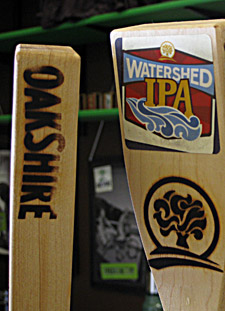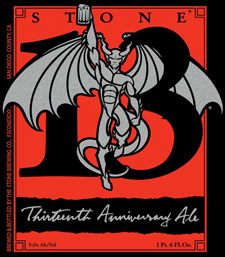 Matt Van Wyk at Oakshire Brewing in Eugene, Oregon, has a new standard answer when he’s asked how many IBU (International Bitterness Units) are in one of his beers. “About one hundred.”
Matt Van Wyk at Oakshire Brewing in Eugene, Oregon, has a new standard answer when he’s asked how many IBU (International Bitterness Units) are in one of his beers. “About one hundred.”
How many in the Perfect Storm Imperial IPA? “About one hundred.”
How many in the Oakshire Wheat? “About one hundred.”
He’s not trying to be rude, just having a little fun at festivals with a question brewers hear all the time. I think the answer is brilliant because it naturally moves the conversation from a number with questionable meaning to one about aroma and flavor.
Make no mistake. Hops are about more than bitterness, about more than being macho. They are about aroma and flavor.
That said, next week Stone Brewing releases its 13th Anniversary Ale and it’s been measured at 100 IBU. I emphasize the word measured because breweries and their fans sometimes toss around crazy claims about beers with 120 IBU and more. Next time somebody tells you a beer clocks 100-plus ask whoever tells that if he or she had seen a proper lab analysis. I know of a couple of beers that have topped 100, but only a couple.
Brewers should know better and what they say should reflect that. First because education has been an important part of craft brewing since the get-go. Second because when it comes to perceived bitterness the big numbers may not be that important. There’s some question if us mere mortals can actually detect any additional bitterness above 60 or 70 IBU.
Why do brewers fall into this trap? Everybody, and that includes me, asks about IBU. The number is a shorthand for telling us the volume of hops added to a recipe, which may well impact aroma and flavor. It’s unfortunate that a number sounds so precise, but is usually based on a formula a heck of a lot more accurate for beers of something sane like 40 IBU. Adjectives would be so much better, although it can be a challenge to describe the difference between piney and in-your-face-big-ass piney.
 Turn up the volume another notch or two from big-ass and you have Stone 13. That was the impression out of the tank when I tasted it, before it was dry-hopped for the second time. For the record Stone calls this a 90-plus IBU beer, but the first batch in the bottle measured dead-on one hundred. The lads in the brewery added four and a half pounds of hops per barrel, more than any Stone beer ever.
Turn up the volume another notch or two from big-ass and you have Stone 13. That was the impression out of the tank when I tasted it, before it was dry-hopped for the second time. For the record Stone calls this a 90-plus IBU beer, but the first batch in the bottle measured dead-on one hundred. The lads in the brewery added four and a half pounds of hops per barrel, more than any Stone beer ever.
They did a quick check on the wort prior to fermentation and it measured about 130 IBU. A pretty impressive number, don’t you think? But . . . “IBUs drop during fermentation because the pH of the liquid drops from about 5.3 to about 4.5,” Stone brewmaster Mitch Steele explained via email. “This reduces the solubility of the iso-alpha-acids, the bittering component of hops, so some bitterness solidifies and drops out, and/or gets absorbed by yeast.”
So now you know what it’s best to say “about” when talking about the IBU in beers brewed with bunches of hops.